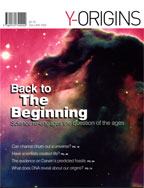LOOK! A HUMAN BEING
The fossil trail has revealed creatures that seem to resemble apes, but have some human-like features. These members of the ape family that scientists call hominids are clearly not human, but evolutionists believe they eventually became us. Evolutionists begin with the premise that life is merely one large family tree (or bush).
They are looking for a trail of fossils that confirm Darwin’s theory of macroevolution of our species. However, if evidence show that Homo sapiens appeared suddenly with qualities and traits distinct from all other forms of life, the possibility that we have been designed becomes apparent.
So have paleoanthropologists been able to bridge the chasm between what they call hominids and us, proving an evolutionary link?
We’ve all seen museum exhibits depicting slightly erect ape-like creatures that presumably became us. These exhibits and drawings in biology textbooks imply that there is solid fossil evidence to back up the claim that such fossils have been discovered. In fact, paleoanthropologists have uncovered pieces of bones and skull fragments from a variety of primates they consider human ancestors. Ardipithecus ramidus, the oldest of these, is dated at over 4 million years old. Homo habilis and Homo erectus are depicted as more recent members of our family tree.
It all looks and sounds so convincing. But what sounds like a solid argument for human ancestry unravels when the facts are made clear. Henry Gee, the chief science writer for Nature writes, “The intervals of time that separate fossils are so huge that we cannot say anything definite about their possible connection through ancestry and descent.”1
The problem is that paleoanthropologists are attempting to fill in an enormous puzzle with only a few fragments of bones and teeth that according to Gee, could be “fitted into a small box.”2 One of the most renowned evolutionists of the twentieth century, Stephen Jay Gould agrees with the difficulty, stating, “Most hominid fossils, even though they serve as a basis for endless speculation and elaborate storytelling, are fragments of jaws and scraps of skulls.”3
Gould is not alone. Harvard zoologist Richard Lewontin also acknowledges: “when we consider the remote past, before the origin of the actual species Homo sapiens, we are faced with a fragmentary and disconnected fossil record.” 4 Yet, these fragments of jaws and scraps of skulls, no matter how sparse and disconnected, have revealed some insightful clues about the uniqueness of our species. Let’s dig deeper.
The first thing that strikes one as odd about Homo sapiens is their appearance on the stage of history. Despite the transitional drawings found in textbooks, intelligent, laptop-carrying man seems to have shown up rather abruptly.
Although small fragments of hominid bones have been discovered, there is a huge jump from such creatures to our own species. Naturalist Ian Tattersall (curator at the American Museum of Natural History) remarks in his book The Fossil Trail: “Something extraordinary, if totally fortuitous, happened with the birth of our species.”5 Tattersall is referring to the suddenness with which humans appear in the fossil record.
Biologists are unable to explain why our species appeared so suddenly. Professor John Maynard Smith, Emeritus of Biology at the University of Sussex writes, “Something very puzzling happened….The fossil evidence is patchy, but it seems that hominids suddenly developed brains that, in terms of size, were much like ours.”6 In other words, the jump from hominids to humans is unexplainable. No links have been discovered.
Most hominids had small, ape-like brains and no capacity for language. Then, suddenly in the fossil record, man appears with several unique features, including an enlarged brain capacity. Why are there no clear-cut links between hominids without language capacity and Homo sapiens?
Back | Endnotes | Next
|




